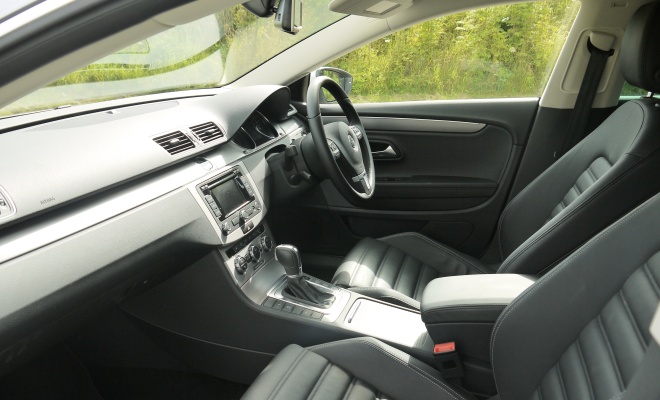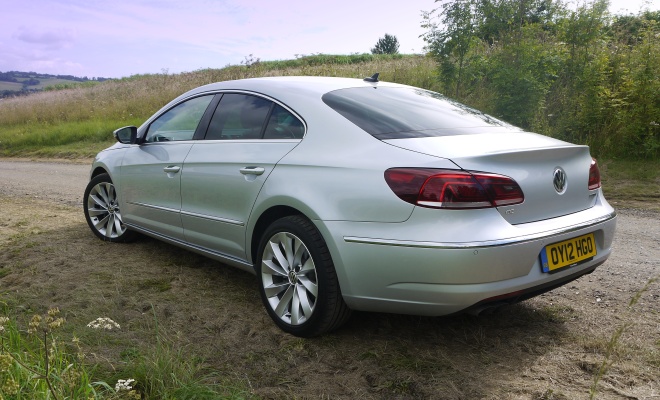
Rating: 3 out of 5 stars
Good: Sleek looks, spacious cabin, feels special
Bad: Obvious Passat bits, vibration, the odd rattle
Price: from £29,230 (the CC range starts at £24,395)
Volkswagen’s CC is an example of a very rare breed. Not four-door coupes, of which there are now a growing number, but cars that have undergone a facelift and come out looking better than before. Good: Sleek looks, spacious cabin, feels special
Bad: Obvious Passat bits, vibration, the odd rattle
Price: from £29,230 (the CC range starts at £24,395)
Of course improving on the original Passat CC was made easier by the old car’s resemblance to a freshly squashed frog. Relatively subtle changes to the rear lights, headlamps, grille and bumpers have produced a much sharper demeanour, more in keeping with the car’s supposed purpose. And that goal is to provide a more stylish alternative to a conventional saloon, while preserving a modicum of practicality via four wide-opening doors and a capacious 452-litre boot.

Volkswagen has dropped “Passat” from the CC’s name along with the facelift, hoping to distance the more rakish car from its humdrum relative. but there’s no escaping the CC’s true family tree from the driving seat. The wheel, instruments, stalks, buttons, centre console, vents, glovebox, gearstick and dashboard are all carried across without modification from the Passat. Plus, of course, much of the hardware under the bonnet or otherwise hidden from view is shared with the saloon.
That isn’t really a criticism – Passat components are no doubt all perfectly reasonable items, with the possible exception of the flimsy feeling stalks. But if VW is serious about positioning the CC a rung above the other car, it may need to try a bit harder with the next edition’s interior.

The company might also need to revisit quality control. While Various Passats I’ve driven have all been solid and squeak free, this particular CC sounds as if a hamster might have set up home under the gearstick. Rougher road surfaces send sufficient vibration into the cabin to set off a scratchy, tiny-claws-on-plastic kind of sound from somewhere deep within the dashboard.
That flaw is a shame because the CC is otherwise a very cosy and welcoming place to travel. The CC sits 49mm lower than the equivalent Passat and – as the swooping roofline suggests – rear headroom may be a deal-breaker if you regularly play host to a basketball team. But the CC’s extra 33mm in length and 35mm in width over the Passat help to provide a feeling of spaciousness from all seats, providing your passengers measure six feet or under.

My particular CC is powered by a 2.0-litre TDI engine developing 140PS (138bhp) and is in GT trim – that’s the more expensive of the two specs on offer in the UK. It came fitted with VW’s excellent DSG automatic gearbox, and with fuel-saving BlueMotion Technology that provides an unobtrusive stop-start system, among other eco tweaks. The combined-cycle economy score is 53.3mpg and its CO2 rating is 139g/km.
I had supposed that the long and low CC might outperform its more upright saloon brother through superior aerodynamics, but a similarly turned out Passat – the Sport 2.0 TDI with BlueMotion Technology and DSG – scores marginally better at 54.3mpg and 135g/km. Kerb weights are very similar, and both manage a swift 9.8-second dash to 62mph, so evidently the CC is not as slippery as it looks.
There is also the trifling matter of cost. My CC has a base price of £29,230 while the equivalent Passat costs from £25,615. The CC GT’s insurance group is also higher at 24 compared with the Passat’s 21, although the difference in actual premiums can turn out to be trivially small. I sought comprehensive quotes for both, and the saving would buy about five litres of diesel.

Both cars sit in the same tax bracket for company car purposes, and with the CC’s superior residual values, running costs work out surprisingly similar over three years. No doubt the stylish CC will prove a popular company car as a result.
On my test I spent 90 minutes on A and B-roads, crawled through some urban sprawl, ran up the motorway for 15 minutes and arrived back at base with the trip meter showing 53.5mpg – surprisingly, a superior result to the official combined cycle score. And that’s despite testing foot-to-the-floor acceleration once or twice. Clearly great economy is on offer for drivers who go looking for it.

The 140PS diesel engine develops 350Nm of torque at 1,750rpm and its strong, unruffled delivery is well suited to the car, particularly when paired with the smooth six-speed DSG automatic. Noise is well suppressed, despite all the door glass being frameless, although overall refinement is let down by a few too many bad vibes from the engine when pottering at low speed.
The GT trim level brings sports suspension, lowered by 15mm and adjustable by prodding a button rather awkwardly hidden on the far side of the gearstick.
Having sampled all three Active Chassis Control settings I find I prefer the Normal setting. The Comfort option might prove relaxing on the motorway, but at slower speeds it sways too much, and while the Sport setting produces a noticeable improvement in body control, if you feel inclined to clip the hedgerows, it’s far too knobbly for everyday use.

The GT edition’s Nappa leather upholstery is a more welcome upgrade, adding to the appeal of the excellent seats. The material looks great too, helping the CC to achieve what it’s supposed to do – feel more special than an ordinary saloon.
On balance, I’d have to conclude that the CC doesn’t do too badly. It does manage to feel a cut above, and could indeed tempt people out of a BMW or Audi – and that’s something the more prosaic Passat could never do.








